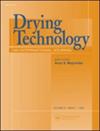径向射流再附着冲击干燥玉米饼
IF 2.7
3区 工程技术
Q3 ENGINEERING, CHEMICAL
引用次数: 0
摘要
摘要本研究通过对新型径向射流再附着(RJR)喷嘴的传热传质行为进行评价,分析脆脆玉米饼的质地和颜色特征。提出并验证了一种新的测量稳态蒸发的实验方法,以确定不同干燥条件下RJR喷嘴的平均对流传热传质系数和几何参数。本实验采用24因子设计方法。考虑的因素包括喷嘴出口角度(10°和45°)、玉米饼厚度(1.03 mm和1.66 mm)、空气干燥温度(200°C和250°C)和空气质量流量(17.0 m3/h和27.2 m3/h)。研究结果表明,在冲击干燥过程中,对流和扩散是选择干燥条件的主要因素。此外,研究表明,45°出口角的RJR喷嘴比10°出口角的RJR喷嘴具有更高的干燥速率。研究发现,喷嘴类型和风干条件对最终产品的质地和颜色都没有显著影响(α≤0.05)。利用RJR喷嘴对玉米饼进行冲击干燥是一种很有前途和强大的工艺,可以在不影响最终产品质量特性的情况下生产脆脆的玉米饼。关键词:撞击式干燥;创新喷嘴;热传质;本研究得到了干燥高级研究中心(CARD)的支持,该中心是位于伍斯特理工学院的国家科学基金会产学研合作研究中心。Rodríguez-Ramírez .作者感谢墨西哥CONACyT获得国际学者奖学金。本文章由计算机程序翻译,如有差异,请以英文原文为准。
Radial Jet Reattachment impingement drying of corn tortillas
AbstractThis study evaluates the heat and mass transfer behavior of innovative Radial Jet Reattachment (RJR) nozzles to analyze the texture and color characteristics of crispy tostadas. A new experimental method for measuring steady-state evaporation is proposed and validated to determine the averaged coefficients of convective heat and mass transfer for different drying conditions and geometrical parameters of RJR nozzles. The experiment is designed using a 24 factorial design approach. The factors that are considered include nozzle exit angle (10° and 45°), tortillas thicknesses (1.03 mm and 1.66 mm), air drying temperature (200 °C and 250 °C) and air mass flow rate (17.0 m3/h and 27.2 m3/h). The findings indicate that for the impingement drying of tortillas, it is crucial to consider convection and diffusion as the primary factors in selecting the appropriate operating conditions. Moreover, the study concludes that the RJR nozzle with a 45° exit angle exhibits a higher drying rate than the RJR nozzle with a 10° exit angle. The study found that neither the type of nozzle nor the air drying conditions had a significant impact (α ≤ 0.05) on the texture and color of the final product. The utilization of RJR nozzles for impinging drying of tortillas is a promising and robust process that enables the production of crispy tostadas without negatively impacting the quality characteristics of the final product.Keywords: Impingement dryinginnovative nozzlesheat and mass transferfood qualityRJR nozzle Disclosure statementNo potential conflict of interest was reported by the author(s).Additional informationFundingThis study was supported by the Center for Advanced Research in Drying (CARD), a National Science Foundation Industry-University Cooperative Research Center located at Worcester Polytechnic Institute. The Rodríguez-Ramírez J. author acknowledges CONACyT of Mexico for the international scholar fellowship.
求助全文
通过发布文献求助,成功后即可免费获取论文全文。
去求助
来源期刊

Drying Technology
工程技术-工程:化工
CiteScore
7.40
自引率
15.20%
发文量
133
审稿时长
2 months
期刊介绍:
Drying Technology explores the science and technology, and the engineering aspects of drying, dewatering, and related topics.
Articles in this multi-disciplinary journal cover the following themes:
-Fundamental and applied aspects of dryers in diverse industrial sectors-
Mathematical modeling of drying and dryers-
Computer modeling of transport processes in multi-phase systems-
Material science aspects of drying-
Transport phenomena in porous media-
Design, scale-up, control and off-design analysis of dryers-
Energy, environmental, safety and techno-economic aspects-
Quality parameters in drying operations-
Pre- and post-drying operations-
Novel drying technologies.
This peer-reviewed journal provides an archival reference for scientists, engineers, and technologists in all industrial sectors and academia concerned with any aspect of thermal or nonthermal dehydration and allied operations.
 求助内容:
求助内容: 应助结果提醒方式:
应助结果提醒方式:


